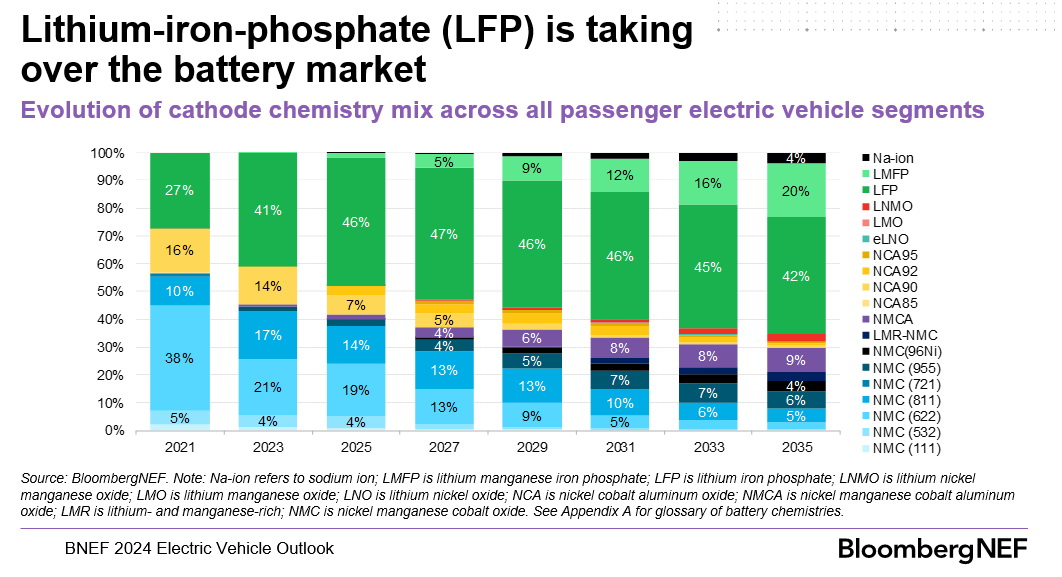
Modern electric and hybrid vehicles use various types of lithium-ion batteries for their traction battery systems. These batteries differ in chemical composition, which determines their performance characteristics, including:
• Capacity,
• Power,
• Safety,
• Lifespan.
Recently, lithium iron phosphate batteries (LiFePO4 or LFP) have become a popular choice for electric vehicles.
Why are LFP Batteries Gaining Popularity?
LFP batteries have several unique properties, some of which significantly outperform other types of lithium-ion batteries:
Safety: Their high chemical and thermal stability minimizes the risk of overheating or fire, even in case of physical damage.
Durability: A long cycle life (charge/discharge cycles) makes their use cost-effective in the long run.
Eco-friendliness: LFP batteries do not contain toxic materials associated with environmental and ethical concerns. Once their life cycle ends, LFP cells are considered low-hazard waste and do not require special disposal methods, unlike other lithium-ion batteries.
Low Cost: The availability and low cost of raw materials, along with the simplicity of the production process, make LFP batteries relatively inexpensive.
However, LFP batteries also have their drawbacks. One of the main disadvantages is their lower energy density compared to other lithium-ion battery types. This means that an electric vehicle with the same battery size will have a shorter range per charge. This drawback limits their use in compact electric cars and vehicles with long ranges, such as the Mercedes-Benz EQS (785 km), Tesla Model S (405 miles or 651 km), BMW i7 (625 km), and Volkswagen ID.7 Pro Match (618 km), among others.
Despite the disadvantages of LFP batteries, the advantages are more significant, which is why they already occupy more than 40% of the electric vehicle battery market. Research from BloombergNEF indicates that this trend will continue, and within a few years, LFP batteries will hold more than 50% of the global electric vehicle battery market share.
Features of Diagnosing LFP Batteries in Electric Vehicles
The diagnostic process for electric vehicle batteries with LiFePO4 cells is similar to diagnosing other types of lithium-ion batteries and involves determining several key parameters that allow assessing the battery’s current state and predicting its future performance.
A common malfunction in an electric vehicle battery is the failure of one or more modules. To find the faulty module, follow these steps:
1. Measuring the Voltage of the Battery Cells: Typically, this procedure is performed using an automotive diagnostic scanner that reads the data from the battery management system (BMS). To perform this procedure, the diagnostic scanner must be capable of working with this specific vehicle model. For example, diagnosing Tesla electric vehicles requires a special diagnostic scanner.
At this stage, we can determine which battery modules have lower voltage compared to the others. When diagnosing LFP batteries, it is essential to note that their voltage characteristics differ from other lithium-ion battery types:
• Nominal cell voltage: 3.2 V (compared to 3.6–3.7 V for other Li-ion batteries),
• Minimum operating cell voltage: 2.5 V (compared to 3.0 V for other Li-ion batteries),
• Charging voltage: 3.65 V (compared to 4.2 V for other Li-ion batteries),
• Minimum allowable voltage: 2.0 V (compared to 2.5 V for other Li-ion batteries).
2. Removing the Potentially Faulty Module: Once a faulty module is identified, it is removed from the battery for further testing.
3. Visual Inspection of the Module: Before proceeding with further tests, inspect the module for physical damage, such as local corrosion, electrolyte leakage, or swelling of module components.
4. Charging the Module: The next step involves fully charging the potentially faulty module while simultaneously balancing the voltage across all its cells. This procedure is performed using a special charger for LiFePO4 batteries or a lithium-ion battery tester that supports LFP batteries.
5. Checking the Internal Resistance of the Module Cells: Internal resistance is a key parameter indicating the overall condition of the cells. In a functional module, the internal resistance of all its cells should be uniform.
6. Capacity Check of the Module Cells: The capacity values of the module cells should also be similar. Capacity is measured by discharging the charged battery while measuring the energy released. This operation is performed using a special lithium-ion battery tester.
7. Checking for Voltage Drops in the Module Cells: The final test, which will provide a definitive answer as to whether the module is functioning properly or not, is the presence of a voltage drop across the module’s components. This is done by measuring the voltage across the cells over a period of time, such as 24 hours. In a functional LiFePO4 battery, there should be no voltage drop within this period.
To perform all steps of LFP battery diagnostics, you need the proper diagnostic equipment. Our range of diagnostic tools includes lithium-ion battery testers, as well as our new MS801 tester, which significantly simplifies and speeds up the testing of high-voltage batteries in electric and hybrid vehicles.
If you want to dive deeper into the specifics of electric vehicle battery diagnostics, you can enroll in the "Diagnostics and Repair of High-Voltage Batteries in Hybrids and Electric Vehicles" course at the MSG Equipment training center.



COMMENTS